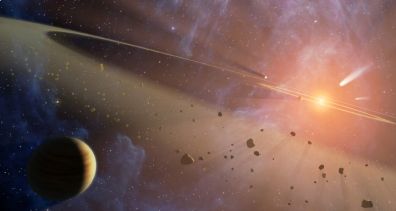The solar system Epsilon Eridani in which the planet Vulcan is found in the science fiction series Star Trek is in reality a solar system much younger than ours, but quite reminiscent of it

In 2000, astronomers discovered a bugdal planet of Jupiter orbiting a star close to our solar system - Epsilon Eridani. Since this star system is mentioned in several Star Trek episodes as the home of the planet Vulcan, astronomers joked that they had found Spock's home world, but interesting discoveries of the Epsilon Eridani system have shown that it is a much younger solar system than ours.
It has two rocky asteroid belts and an outer icy ring, making it a triple ring system. The inner asteroid belt is quite similar to the outer asteroid belt of the Solar System (the Kuiper belt), while the outer asteroid belt of Epsilon Eridani contains 20 times more material than the inner belt. The meaning of the existence of these belts is that planets that have not been seen so far are hiding there, and they cause the sharpening of the rings. However, if a civilization could develop in the area, let's hope they are more like Spock than Captain Kirk's evil twin.
Epsilon Eridani is the ninth star from the Sun. It is smaller and colder than our Sun, and is located about 10.5 light years from Earth in the direction of the constellation Aridanus. Epsilon Eridani is visible and is younger than the Sun - a total of about 850 million years old. Astronomers say that Epsilon Eridani's solar system is remarkably similar to our own solar system as it was at that age.
"Study of Epsilon Eridani is like stepping into a time machine and seeing our solar system when it was young," says astronomer Massimo Marengo of the Smithsonian Institution. Dana Beckman of the Seti Institute agrees and says: "The system looks almost as surely as the solar system looked when the first life took root on Earth." The two astronomers' research will appear in the January 10 issue of the Astrophysical Journal.

8 תגובות
Thank you, father, I already thought I was delusional...
I deleted the word, simply because of the appearance of both stars and planets in the same news, a mistake was made, I received the comment and I thank someone. If I had his email I would thank him in person, because I always fix this particular mistake in a lot of places that haven't learned the difference. Even when I was in Israel I insisted on this and when I left the planets returned to become just stars.
someone:
I don't see the second quote you gave.
It seems to me that you added the word "went" yourself (unless they corrected the article according to your comment and forgot to thank you)
I did not understand anything.
It used to be written: "Epsilon Aridani solar system" -
And once it is written: "Epsilon Eridani is the ninth planet in its distance from the Sun",
(And so that you don't let the facts confuse you, it is also written like this: interesting discoveries of
Epsilon Eridani system).
So "Epsilon Erid(a)ni is a sun, or a planet?
And what exactly did the poet mean?!
Hi Kirk good to know.
Maybe you know, McCain is volcanic?
What's interesting is that Leonard Nimoy, the actor who plays Spock, once said in an interview that the Vulcan race reminded him of the Jewish people (the race that lives on Earth, to remind you). Therefore, he gave his character - and thus the entire Vulcan race - the same "peace blessing" based on On the way the priests lay their hands during the priest's blessing.
Spooky
What does this say about our "shared home" in the galaxy?
Are we in the region of star formation?
And how can it be explained that in the same limited area of the galaxy you can find stars of such different ages, 850 million, the age of the epsilon radian compared to about 5 billion years, which is roughly the age of AD?